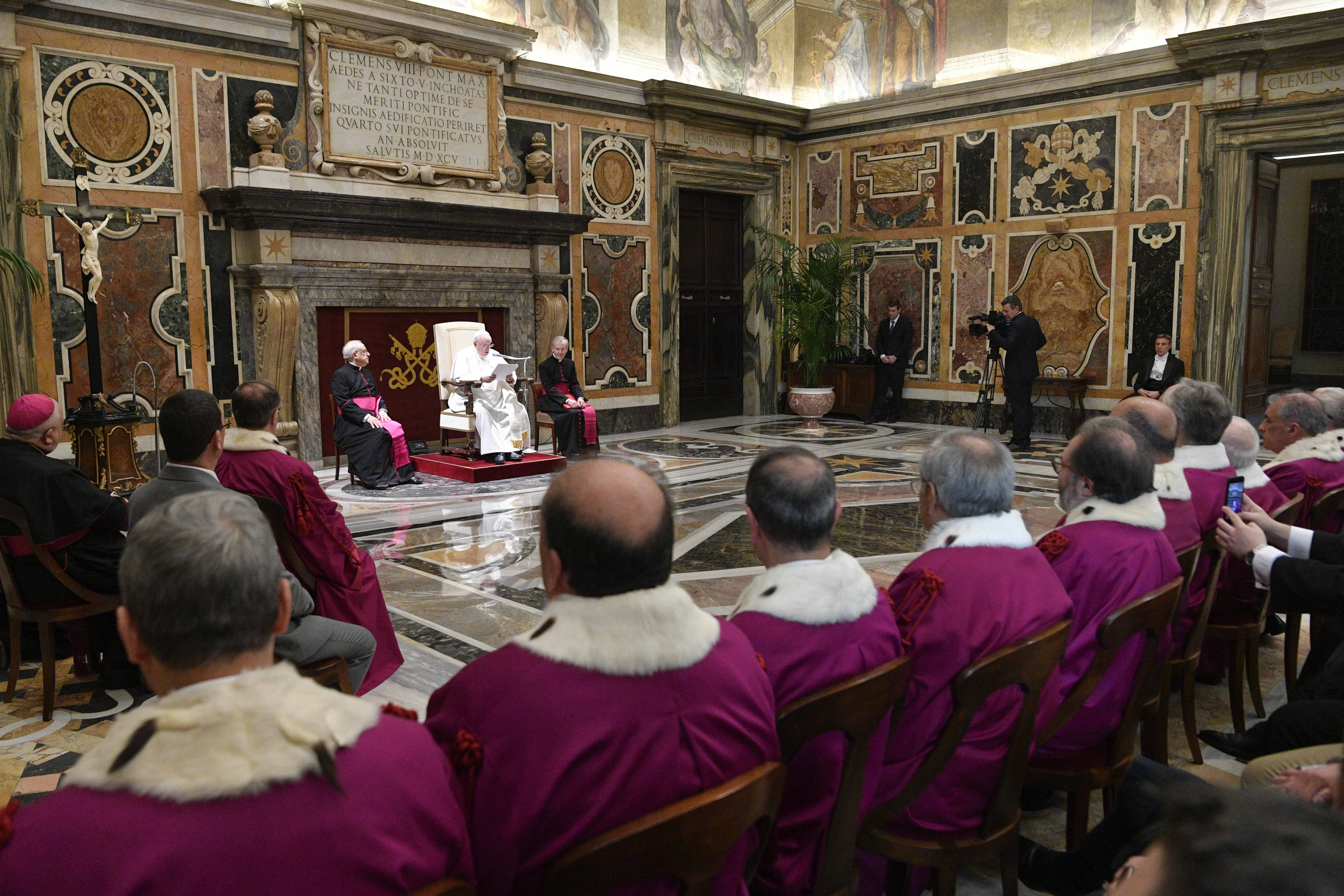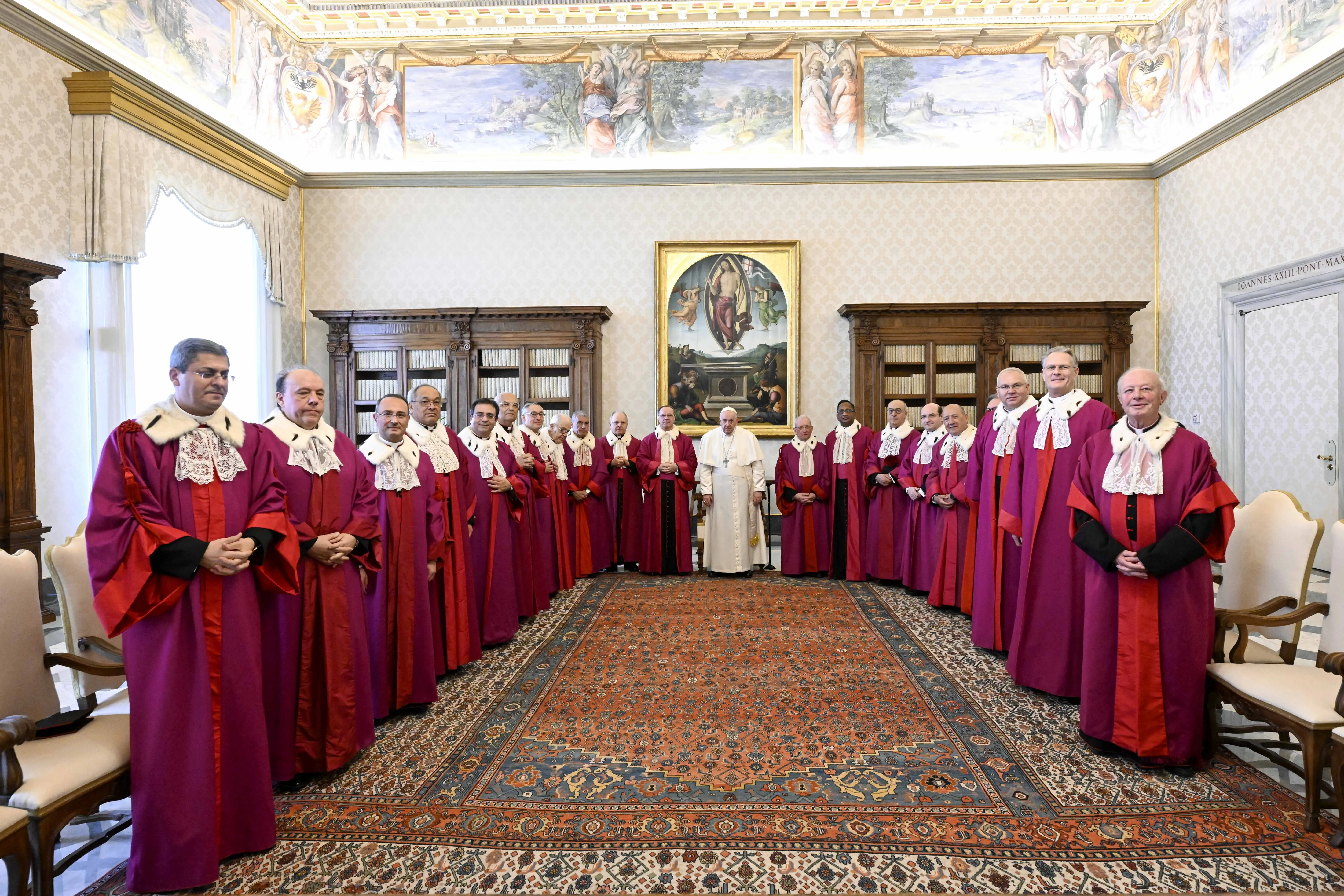
Rome Newsroom, Jan 27, 2023 / 11:40 am (CNA).
Pope Francis on Friday reiterated the Church’s perennial teaching on marriage as a lifelong union between a man and a woman.
“Today I would like to share with you some reflections on marriage, because there is a strong need in the Church and in the world to rediscover the meaning and value of the conjugal union between a man and a woman on which the family is founded,” the pope said Jan. 27 in the Vatican’s apostolic palace.
“Indeed,” he added, “a certainly not minor aspect of the crisis affecting so many families is the practical ignorance, personal and collective, about marriage.”
Pope Francis spoke about marriage during a meeting with the lawyers, auditors, and collaborators of the Tribunal of the Roman Rota for the inauguration of the judicial year.

The Roman Rota is one of three courts within the Holy See and is akin to a court of appeals or court of “last instance.” It is also where marriage nullity cases are judged.
Quoting from his 2013 apostolic exhortation Evangelii gaudium, Pope Francis underlined that marriage “is a reality with its own precise essence, not ‘a mere form of affective gratification that can be constituted in any way and modified according to each person’s sensitivity.’”
One may ask, he said, how it is possible for men and women, with all the limitations and fragility of human beings, to commit to “a union that is faithful and forever and from which a new family is born?”
Confronted with this question, and with the crises facing many families today, the Church needs to renew awareness in the gift of grace received through a sacramental marriage, he said.
The gift received in the sacrament of matrimony, he said, is “an irrevocable gift, a source of grace which we can always count on.”
Pope Francis also emphasized, quoting the constitution Gaudium et spes, that “God himself is the author of marriage.”
“And this can be understood to refer to every single conjugal union,” he added.
The pope told the tribunal that the Church needs “to rediscover the permanent reality of marriage as a bond.”

The Catholic Church teaches that marriage is a lifelong partnership. When a Church tribunal issues a declaration of nullity of a marriage, it means that the marriage never existed.
The word “bond,” Francis noted, “is sometimes looked upon with suspicion, as if it were an external imposition, a burden, a ‘tether’ in opposition to the authenticity and freedom of love.”
“If, on the other hand, the bond is understood precisely as a bond of love, then it is revealed as the core of marriage, as a divine gift that is the source of true freedom and which guards married life,” he said.
If you value the news and views Catholic World Report provides, please consider donating to support our efforts. Your contribution will help us continue to make CWR available to all readers worldwide for free, without a subscription. Thank you for your generosity!
Click here for more information on donating to CWR. Click here to sign up for our newsletter.





And yet, as the Argentine Bishops’ Letter suggests, I can also discern that it is not presently possible for me to abstain from sex outside what technically, theologically counts as marriage if to do otherwise would lead me into a greater sin?
For once, Pope Francis’ words make sense.
Say one thing, do another.
And contrary to those who you appointed to Pontifical Councils, etc… all use of Contraception destroys that bond! Destroys that union! Turns the marital act into a selfish act. Sterilizes it. Be Holy, as I am Holy, God tells us. I am tired of doublespeak coming from the Vatican. Thinking Cardinal Paglia, Cardinal Hollerixch, Cardinal Marx, Cardinal Kasper, Cardinal Cupich, Cardinal McElroy, etc… They all twist God’s law like some shady attorney looking for loopholes. The old theological question was, “How many angels can dance on a pin head?” The new one these cardinals ask is, “How far can we twist and bend the Word of God for our own selfish purposes?” No one cares a wit about what God desires from us. These guys are impressed by their own theology.
I’m surprised Pope Francis didn’t toss the text aside and start using the F word.
“to rediscover the permanent reality of marriage as a bond.”
One wonders how words like this can come out of the same mouth that produced the relative nonsense contained in AMORIS LAETITIA.